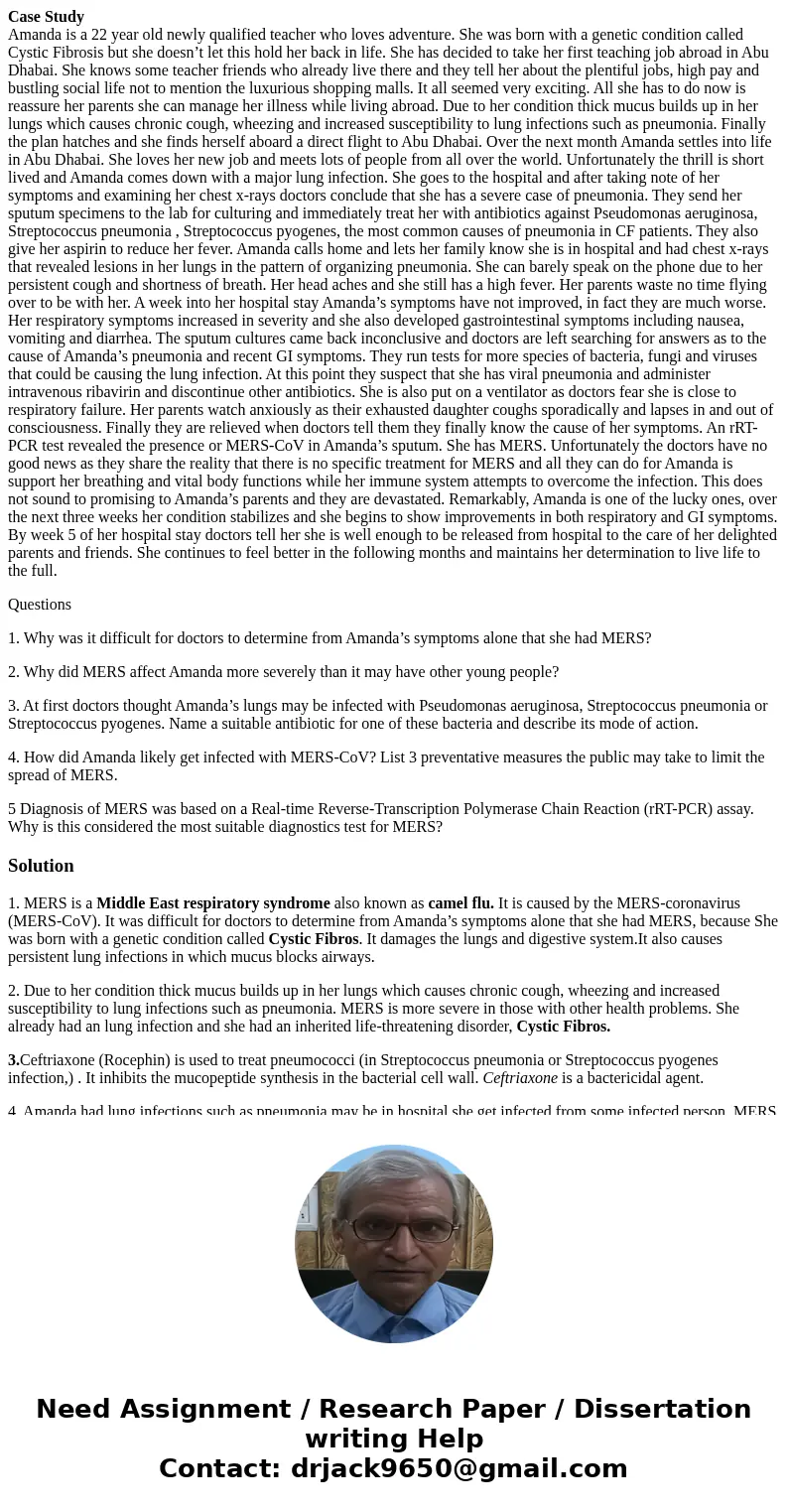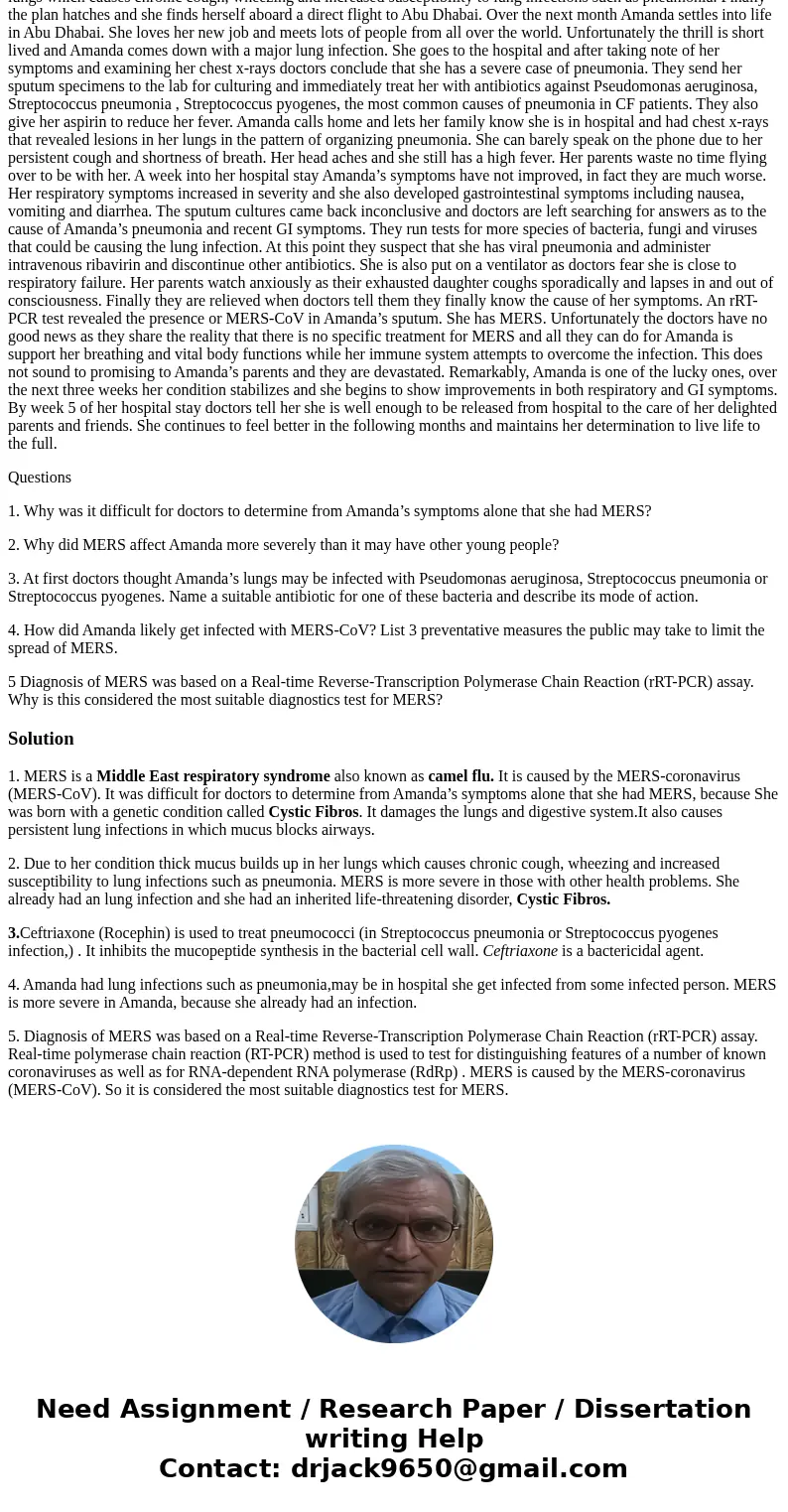Case Study Amanda is a 22 year old newly qualified teacher w
Case Study
Amanda is a 22 year old newly qualified teacher who loves adventure. She was born with a genetic condition called Cystic Fibrosis but she doesn’t let this hold her back in life. She has decided to take her first teaching job abroad in Abu Dhabai. She knows some teacher friends who already live there and they tell her about the plentiful jobs, high pay and bustling social life not to mention the luxurious shopping malls. It all seemed very exciting. All she has to do now is reassure her parents she can manage her illness while living abroad. Due to her condition thick mucus builds up in her lungs which causes chronic cough, wheezing and increased susceptibility to lung infections such as pneumonia. Finally the plan hatches and she finds herself aboard a direct flight to Abu Dhabai. Over the next month Amanda settles into life in Abu Dhabai. She loves her new job and meets lots of people from all over the world. Unfortunately the thrill is short lived and Amanda comes down with a major lung infection. She goes to the hospital and after taking note of her symptoms and examining her chest x-rays doctors conclude that she has a severe case of pneumonia. They send her sputum specimens to the lab for culturing and immediately treat her with antibiotics against Pseudomonas aeruginosa, Streptococcus pneumonia , Streptococcus pyogenes, the most common causes of pneumonia in CF patients. They also give her aspirin to reduce her fever. Amanda calls home and lets her family know she is in hospital and had chest x-rays that revealed lesions in her lungs in the pattern of organizing pneumonia. She can barely speak on the phone due to her persistent cough and shortness of breath. Her head aches and she still has a high fever. Her parents waste no time flying over to be with her. A week into her hospital stay Amanda’s symptoms have not improved, in fact they are much worse. Her respiratory symptoms increased in severity and she also developed gastrointestinal symptoms including nausea, vomiting and diarrhea. The sputum cultures came back inconclusive and doctors are left searching for answers as to the cause of Amanda’s pneumonia and recent GI symptoms. They run tests for more species of bacteria, fungi and viruses that could be causing the lung infection. At this point they suspect that she has viral pneumonia and administer intravenous ribavirin and discontinue other antibiotics. She is also put on a ventilator as doctors fear she is close to respiratory failure. Her parents watch anxiously as their exhausted daughter coughs sporadically and lapses in and out of consciousness. Finally they are relieved when doctors tell them they finally know the cause of her symptoms. An rRT-PCR test revealed the presence or MERS-CoV in Amanda’s sputum. She has MERS. Unfortunately the doctors have no good news as they share the reality that there is no specific treatment for MERS and all they can do for Amanda is support her breathing and vital body functions while her immune system attempts to overcome the infection. This does not sound to promising to Amanda’s parents and they are devastated. Remarkably, Amanda is one of the lucky ones, over the next three weeks her condition stabilizes and she begins to show improvements in both respiratory and GI symptoms. By week 5 of her hospital stay doctors tell her she is well enough to be released from hospital to the care of her delighted parents and friends. She continues to feel better in the following months and maintains her determination to live life to the full.
Questions
1. Why was it difficult for doctors to determine from Amanda’s symptoms alone that she had MERS?
2. Why did MERS affect Amanda more severely than it may have other young people?
3. At first doctors thought Amanda’s lungs may be infected with Pseudomonas aeruginosa, Streptococcus pneumonia or Streptococcus pyogenes. Name a suitable antibiotic for one of these bacteria and describe its mode of action.
4. How did Amanda likely get infected with MERS-CoV? List 3 preventative measures the public may take to limit the spread of MERS.
5 Diagnosis of MERS was based on a Real-time Reverse-Transcription Polymerase Chain Reaction (rRT-PCR) assay. Why is this considered the most suitable diagnostics test for MERS?
Solution
1. MERS is a Middle East respiratory syndrome also known as camel flu. It is caused by the MERS-coronavirus (MERS-CoV). It was difficult for doctors to determine from Amanda’s symptoms alone that she had MERS, because She was born with a genetic condition called Cystic Fibros. It damages the lungs and digestive system.It also causes persistent lung infections in which mucus blocks airways.
2. Due to her condition thick mucus builds up in her lungs which causes chronic cough, wheezing and increased susceptibility to lung infections such as pneumonia. MERS is more severe in those with other health problems. She already had an lung infection and she had an inherited life-threatening disorder, Cystic Fibros.
3.Ceftriaxone (Rocephin) is used to treat pneumococci (in Streptococcus pneumonia or Streptococcus pyogenes infection,) . It inhibits the mucopeptide synthesis in the bacterial cell wall. Ceftriaxone is a bactericidal agent.
4. Amanda had lung infections such as pneumonia,may be in hospital she get infected from some infected person. MERS is more severe in Amanda, because she already had an infection.
5. Diagnosis of MERS was based on a Real-time Reverse-Transcription Polymerase Chain Reaction (rRT-PCR) assay. Real-time polymerase chain reaction (RT-PCR) method is used to test for distinguishing features of a number of known coronaviruses as well as for RNA-dependent RNA polymerase (RdRp) . MERS is caused by the MERS-coronavirus (MERS-CoV). So it is considered the most suitable diagnostics test for MERS.


 Homework Sourse
Homework Sourse